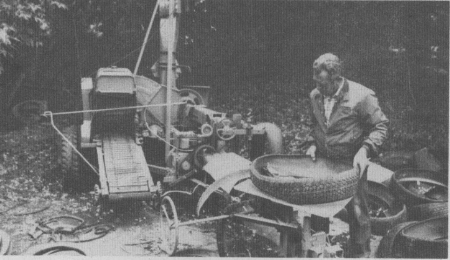
Dave Geister, Prescott, Wis., uses old forage harvesters to turn tires into small rubber chunks that he calls "rubber rock" for use as sidewalks, driveways, playgrounds, and to mix into concrete to create a non-slip "soft stand" surface that's great for livestock.
FARM SHOW reported on Geister's many new uses for tires earlier this year (Vol. 13, No. 1). Since our first report he's come up with more new ideas and machines that help turn junked tires into valuable assets.
"We've had tremendous interest in rubber rock which makes an attractive, non-slip surface that's easy to walk on. It's much better than wood chips, which can rot, or stones, which are hard to walk on," says Geister. "It cleans off your feet so you don't track sand and mud into the house, or barn. Rain keeps it clean and snow melts off fast because of the dark color."
Geister's excited about a new use he recently discovered for the small rubber chunks. He mixes "rubber rock" into concrete to create a cushioned floor that's got all the advantages of concrete with the comfort and non-slick surface of rubber. Rubber goes into the concrete along with the sand and other ingredients. As the concrete hardens, he uses a hose to wash away the surface and expose the chunks of rubber. "It eliminates the need for rubber cow mats, which are unsanitary and can shelter insects and bacteria. It also makes a slip-proof surface that prevents livestock injuries and eliminates the need to groove concrete with expensive saws. We're already working with a concrete manufacturer who wants to put rubber rock into precast concrete slabs."
To make "rubber rock", Geister converted an old New Holland pull-type forage chopper. A cutting wheel on the tongue of the forage harvester slices tires into 3/4 in. wide strips (one tires makes a 35-ft. long strip). Geister feeds the strips into the forage harvester via conveyor belt. The strips are chopped into pieces 1/4 to 1 in. long and then discharged out the back to a trailing wagon.
Geister drives the tire chopper with a 10 hp Briggs & Stratton gas engine mounted on the tongue. It belt-drives a pair of transmissions that drive the flywheel and conveyor (a Dodge car transmission) and the 6 1/2-in. dia. tire slicing blade (an old Massey Harris combine transmission).
The tire sidewalls are cut out with a special air-powered knife and then the steel-belted treads are separated from the bias ply tires with an inexpensive metal detector, and then he slices the treads into strips to feed into the machine. By changing gears on the 3-speed Dodge transmission that drives the conveyor and chopper head, he can regulate the size of "rubber rock". "I use third gear for sidewalls, but first gear for steel-belted treads because they're harder to cut," notes Geister.
A half-section of tire mounted on the discharge spout directs rubber chunks into a wagon. A safety bar and shields cover all open parts of the machine.
Geister also recently modified a 165 hp 1977 Oliver 840 self-propelled forage harvester powered by a 1979 4-cyl. Pontiac engine and transmission. "It lets me chop 800 to 1,000 tires per day," says Geister. "The chopper is equipped with 6 tungsten cutting knives, a tungsten cutter bar, and a recutter screen. I don't have to cut tires into strips before feeding them into the conveyor thanks to the powerful motor and the recutter screen, located under the spiral knives. I can feed an entire tread or sidewall into the conveyor. Rubber is continuously cut into smaller chunks until the chunks fit through the holes of the recutter screen."
Geister
sells rubber rock in 55-gal. drums, wholesale bulk orders, rubber strips and sidewalls. Geister also sells a booklet, "The Second
Life of Tires", which out-lines 100 alternative uses for tires.
He also offers a 2-hour video that describes how to cut tires using basic tools,
how to use tires for soil erosion control practices, how to make "rubber
rock", and how to build play-ground equipment out of tires.
